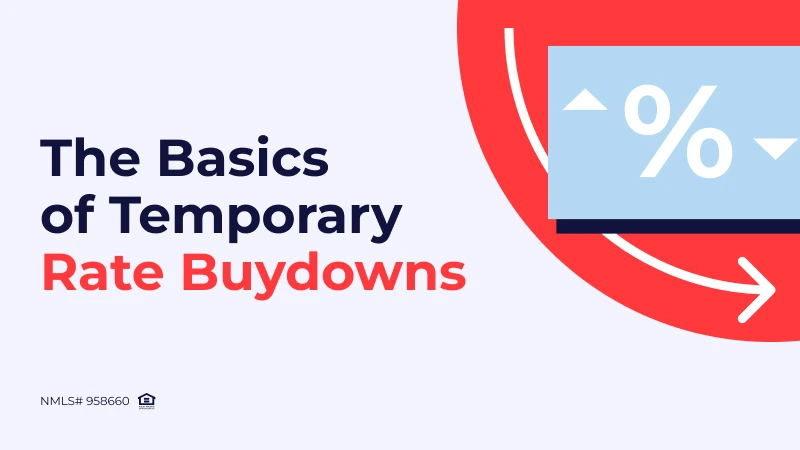
Temporary rate buydown is a popular option for mortgage brokers looking to reduce their clients’ interest rates. By offering a reduced interest rate for the initial years of the mortgage term, borrowers can ease into their payments, enjoy reduced costs upfront, and use the savings for other expenses. In this blog post, we will cover the basics of temporary rate buydowns. You’ll learn different types of temporary rate buydowns available at A&D Mortgage and their advantages and disadvantages.
This article was originally published on December 22, 2022.
What is a Temporary Rate Buydown?
A temporary rate buydown is an arrangement between a borrower and a seller (or another party) that allows for a lower interest rate for the first few years of the mortgage. The purpose is to provide the borrower with lower monthly payments during the early years of homeownership, often when expenses are highest. The reduction can last for one to three years, with the interest rate gradually increasing to the originally agreed-upon rate after the buydown period ends.
Get the ADvantage
with our loyalty program
Earn and redeem points for valuable benefits for you and your clients
Unlock RewardsDuring the buydown term, the interest rate is subsidized by funds placed in an escrow account, paid by the seller, lender, or a third party. These funds supplement the mortgage payments, temporarily reducing the borrower’s monthly burden.
Types of Temporary Rate Buydowns
Temporary rate buydowns come in various forms. Here are the two primary options offered by A&D Mortgage:
- 3-2-1 Buydown. This buydown reduces the interest rate by 3% in the first year, 2% in the second year, and 1% in the third year. After the third year, the rate returns to the originally locked-in rate for the remainder of the loan term.
- 2-1 Buydown. This buydown reduces the interest rate by 2% in the first year and 1% in the second year. The rate returns to the locked-in rate in the third year and continues for the rest of the term.
Both buydowns help borrowers ease into their mortgage payments by lowering costs in the initial years.
How Do Temporary Rate Buydowns Work?
Temporary rate buydowns are funded at closing, where the seller, builder, or mortgage lender deposits a lump sum into an escrow account to cover the interest reduction. For the agreed-upon period (one to three years), these funds supplement the borrower’s payments, ensuring that the lender still receives the full interest payment.
At the end of the buydown period, the borrower resumes making payments at the original, higher interest rate.
Advantages of Temporary Rate Buydowns
- Lower Initial Payments. The most significant advantage is the ability to reduce monthly payments in the first few years, which can be crucial for borrowers who anticipate higher expenses, such as moving costs or home improvements, shortly after purchasing their home.
- Increased Affordability. This strategy can make homeownership more accessible for first-time homebuyers, helping them qualify for larger loans.
- Seller Incentive. In a buyer’s market, sellers may offer to fund a buydown to attract buyers without having to lower the home price.
- Potential to Save on Interest. If a borrower plans to refinance or sell the home within the buydown period, they may never pay the full interest rate, making this an even more attractive option.
Disadvantages of Temporary Rate Buydowns
- Higher Future Payments. While initial payments are lower, the borrower must be ready for higher payments once the buydown period ends. If the borrower’s income does not increase as expected, they may struggle to afford the mortgage.
- Potential Costs. The cost of the buydown, paid by the seller or another party, could mean that the home price is not negotiable, or other incentives (such as closing cost assistance) are not available.
- Temporary Solution. The buydown only offers a short-term benefit. Borrowers must be financially ready to handle the full loan payments once the buydown period ends.
How A&D Mortgage’s Buydown Programs Compare
A&D Mortgage offers two types of temporary rate buydowns as part of their Non-QM products, designed to meet needs of borrowers.
- 3-2-1 and 2-1 Buydowns for primary residences and second homes, with flexible property types like SFR, condos, and PUDs.
- Contributions to fund the buydown can come from the seller or third party, or even be split.
Unlike some lenders, A&D Mortgage’s temporary buydowns offer flexibility without requiring interest-only loans. Thanks to that, borrowers enjoy the benefits without restrictions like manufactured home exclusions.
Conclusion
Temporary rate buydowns is a solution for borrowers looking to manage their finances effectively during the early years of their mortgage. By offering reduced interest rates for a set period, mortgage brokers can help clients ease into homeownership. However, you should be careful with the decision to pursue a buydown. You should give consideration to both short-term advantages and long-term financial readiness.
Choose a top nationwide lender that cares about your growth!
Get StartedIf you’re a mortgage broker looking to expand your options for clients, consider becoming a partner with A&D Mortgage. See how temporary buydown programs can help your clients achieve their homeownership goals with flexibility and financial ease.


